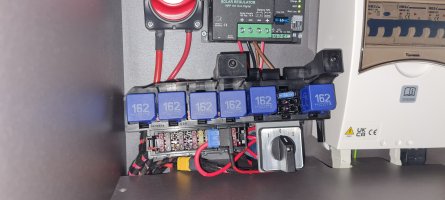markab
VIP Member
I have done a fair bit of reading through the forums on Power Banks and integration, I would like to increase the capability of our 600 by a day or so, I considered solar but it seems to be a bit of a pain on the 600. Really we are never off grid for more than a couple of days. I also contacted a supplier around fitting a LifePO4 and a split charger but the quotes for that are north 3000.
What I intend to do for now is install a victron filax 2 auto change over and integrate it with a DJI power 2000 which has a 3000w inverter. EHU will be connected to the primary on the filax and the power bank 230 output to the secondary of the filax, the load port from the filax will then supply the 230 consumer unit in the GC600. A second feed will be taken from the EHU before the filax and will be connected to the charge port of the power bank. I will add an isolator switch on the supply to GC600 charger and on the Power Bank charge feed.
Under basic operation when on EHU, EHU will supply the Van and charge both the GC battery and the Power Bank charger. When EHU is disconnected the filax will auto switch to the power bank 230 supply, the power bank will not be charged as it was fed from the EHU. I can then decide if I would like the power bank to feed the GC charger or just supply the van.
I think I can achieve this with the Filax a couple of isolation switches, some wago connectors and some flex so the whole thing is pluggable without the need to modify the GC wiring.
Anyone used a filax to achieve this?

What I intend to do for now is install a victron filax 2 auto change over and integrate it with a DJI power 2000 which has a 3000w inverter. EHU will be connected to the primary on the filax and the power bank 230 output to the secondary of the filax, the load port from the filax will then supply the 230 consumer unit in the GC600. A second feed will be taken from the EHU before the filax and will be connected to the charge port of the power bank. I will add an isolator switch on the supply to GC600 charger and on the Power Bank charge feed.
Under basic operation when on EHU, EHU will supply the Van and charge both the GC battery and the Power Bank charger. When EHU is disconnected the filax will auto switch to the power bank 230 supply, the power bank will not be charged as it was fed from the EHU. I can then decide if I would like the power bank to feed the GC charger or just supply the van.
I think I can achieve this with the Filax a couple of isolation switches, some wago connectors and some flex so the whole thing is pluggable without the need to modify the GC wiring.
Anyone used a filax to achieve this?




















